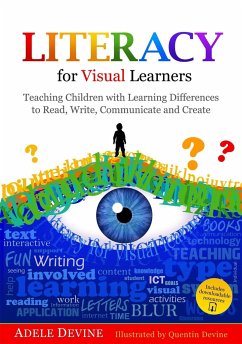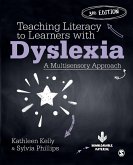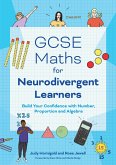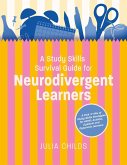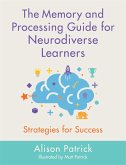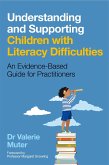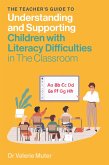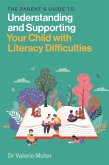Adele DevineTeaching Children with Learning Differences to Read, Write, Communicate and Create
Literacy for Visual Learners
Teaching Children with Learning Differences to Read, Write, Communicate and Create
Illustrator: Devine, Quentin
Adele DevineTeaching Children with Learning Differences to Read, Write, Communicate and Create
Literacy for Visual Learners
Teaching Children with Learning Differences to Read, Write, Communicate and Create
Illustrator: Devine, Quentin
- Broschiertes Buch
- Merkliste
- Auf die Merkliste
- Bewerten Bewerten
- Teilen
- Produkt teilen
- Produkterinnerung
- Produkterinnerung
This book provides exciting new strategies for teaching literacy to children with special educational needs. Keeping the strengths of visual learners at the heart of each strategy, the author shares tried-and tested ways to develop key reading, writing, comprehension and communication skills.
Andere Kunden interessierten sich auch für
![Teaching Literacy to Learners with Dyslexia Teaching Literacy to Learners with Dyslexia]() Kathleen KellyTeaching Literacy to Learners with Dyslexia54,99 €
Kathleen KellyTeaching Literacy to Learners with Dyslexia54,99 €![GCSE Maths for Neurodivergent Learners GCSE Maths for Neurodivergent Learners]() Judy HornigoldGCSE Maths for Neurodivergent Learners41,99 €
Judy HornigoldGCSE Maths for Neurodivergent Learners41,99 €![A Study Skills Survival Guide for Neurodivergent Learners A Study Skills Survival Guide for Neurodivergent Learners]() Julia ChildsA Study Skills Survival Guide for Neurodivergent Learners22,99 €
Julia ChildsA Study Skills Survival Guide for Neurodivergent Learners22,99 €![The Memory and Processing Guide for Neurodiverse Learners The Memory and Processing Guide for Neurodiverse Learners]() Alison PatrickThe Memory and Processing Guide for Neurodiverse Learners33,99 €
Alison PatrickThe Memory and Processing Guide for Neurodiverse Learners33,99 €![Understanding and Supporting Children with Literacy Difficulties Understanding and Supporting Children with Literacy Difficulties]() Valerie MuterUnderstanding and Supporting Children with Literacy Difficulties29,99 €
Valerie MuterUnderstanding and Supporting Children with Literacy Difficulties29,99 €![The Teacher's Guide to Understanding and Supporting Children with Literacy Difficulties in the Classroom The Teacher's Guide to Understanding and Supporting Children with Literacy Difficulties in the Classroom]() Valerie MuterThe Teacher's Guide to Understanding and Supporting Children with Literacy Difficulties in the Classroom24,99 €
Valerie MuterThe Teacher's Guide to Understanding and Supporting Children with Literacy Difficulties in the Classroom24,99 €![The Parent's Guide to Understanding and Supporting Your Child with Literacy Difficulties The Parent's Guide to Understanding and Supporting Your Child with Literacy Difficulties]() Valerie MuterThe Parent's Guide to Understanding and Supporting Your Child with Literacy Difficulties22,99 €
Valerie MuterThe Parent's Guide to Understanding and Supporting Your Child with Literacy Difficulties22,99 €-
-
-
This book provides exciting new strategies for teaching literacy to children with special educational needs. Keeping the strengths of visual learners at the heart of each strategy, the author shares tried-and tested ways to develop key reading, writing, comprehension and communication skills.
Produktdetails
- Produktdetails
- Verlag: Jessica Kingsley Publishers
- Seitenzahl: 288
- Erscheinungstermin: 21. Oktober 2015
- Englisch
- Abmessung: 246mm x 172mm x 20mm
- Gewicht: 528g
- ISBN-13: 9781849055987
- ISBN-10: 184905598X
- Artikelnr.: 42482612
- Herstellerkennzeichnung
- Libri GmbH
- Europaallee 1
- 36244 Bad Hersfeld
- gpsr@libri.de
- Verlag: Jessica Kingsley Publishers
- Seitenzahl: 288
- Erscheinungstermin: 21. Oktober 2015
- Englisch
- Abmessung: 246mm x 172mm x 20mm
- Gewicht: 528g
- ISBN-13: 9781849055987
- ISBN-10: 184905598X
- Artikelnr.: 42482612
- Herstellerkennzeichnung
- Libri GmbH
- Europaallee 1
- 36244 Bad Hersfeld
- gpsr@libri.de
Adele Devine, illustrated by Quentin Devine
Acknowledgements. Introduction - A Fairy Tale. 1. Visual Learners are in
EVERY Classroom (Preventing a learning difference from becoming a learning
difficulty). 2. Learning Differences and Disabilities. (Autism Spectrum
Conditions, Dyslexia, Dysgraphia, Dyspraxia, Downs Syndrome, ADHD, Cerebral
Palsy and physical disabilities affecting communication). 3. Gifted Visual
Learners Past and Present. 4. Visual Teachers (Past and Present). 5. First
Impressions! (How we introduce literacy can help develop positive attitude
to learning.) 6. Motivation to learn (Finding out what motivates the
individual child can be the key to engaging them to want to learn. 7.
Teaching writing right (Setting them up to succeed, by stepping learning to
meet individual needs - sandpaper letters, stamps and pencil grips). 8.
What's in a name? (How names and labels give reading and writing a
purpose). 9. Reading (Practical strategies including teaching children who
do not 'get' phonics). 10. Sight Reading High Frequency Words (a structured
approach). 11. Visuals for Communication (An Introduction to Picture
Exchange Communication and going beyond 'I want...'). 12. Augmentative
Assistive Communication (Switches, buttons, android, eye gaze and iPad
Apps). 13. Actions speak louder! (Gaining Attention, adding meaning and
improving communication through actions and signing). 14. Listening and
Gaining Attention (Becoming a good listener, Tutorials, Intensive
Interaction and Attention Autism). 15. Functional Communication (Within
school and out and about). 16. Implementing subject based TEACCH. 17. SEN
Assist (Teaching Literacy through the Class Computer). 18. Drama and Dance
and Shakespeare (Bringing stories to life using costume, masks and
puppets). 19. Look here! They can! (Believing in futures). 20. Happy
Endings. Resources. Index.
EVERY Classroom (Preventing a learning difference from becoming a learning
difficulty). 2. Learning Differences and Disabilities. (Autism Spectrum
Conditions, Dyslexia, Dysgraphia, Dyspraxia, Downs Syndrome, ADHD, Cerebral
Palsy and physical disabilities affecting communication). 3. Gifted Visual
Learners Past and Present. 4. Visual Teachers (Past and Present). 5. First
Impressions! (How we introduce literacy can help develop positive attitude
to learning.) 6. Motivation to learn (Finding out what motivates the
individual child can be the key to engaging them to want to learn. 7.
Teaching writing right (Setting them up to succeed, by stepping learning to
meet individual needs - sandpaper letters, stamps and pencil grips). 8.
What's in a name? (How names and labels give reading and writing a
purpose). 9. Reading (Practical strategies including teaching children who
do not 'get' phonics). 10. Sight Reading High Frequency Words (a structured
approach). 11. Visuals for Communication (An Introduction to Picture
Exchange Communication and going beyond 'I want...'). 12. Augmentative
Assistive Communication (Switches, buttons, android, eye gaze and iPad
Apps). 13. Actions speak louder! (Gaining Attention, adding meaning and
improving communication through actions and signing). 14. Listening and
Gaining Attention (Becoming a good listener, Tutorials, Intensive
Interaction and Attention Autism). 15. Functional Communication (Within
school and out and about). 16. Implementing subject based TEACCH. 17. SEN
Assist (Teaching Literacy through the Class Computer). 18. Drama and Dance
and Shakespeare (Bringing stories to life using costume, masks and
puppets). 19. Look here! They can! (Believing in futures). 20. Happy
Endings. Resources. Index.
Acknowledgements. Introduction - A Fairy Tale. 1. Visual Learners are in
EVERY Classroom (Preventing a learning difference from becoming a learning
difficulty). 2. Learning Differences and Disabilities. (Autism Spectrum
Conditions, Dyslexia, Dysgraphia, Dyspraxia, Downs Syndrome, ADHD, Cerebral
Palsy and physical disabilities affecting communication). 3. Gifted Visual
Learners Past and Present. 4. Visual Teachers (Past and Present). 5. First
Impressions! (How we introduce literacy can help develop positive attitude
to learning.) 6. Motivation to learn (Finding out what motivates the
individual child can be the key to engaging them to want to learn. 7.
Teaching writing right (Setting them up to succeed, by stepping learning to
meet individual needs - sandpaper letters, stamps and pencil grips). 8.
What's in a name? (How names and labels give reading and writing a
purpose). 9. Reading (Practical strategies including teaching children who
do not 'get' phonics). 10. Sight Reading High Frequency Words (a structured
approach). 11. Visuals for Communication (An Introduction to Picture
Exchange Communication and going beyond 'I want...'). 12. Augmentative
Assistive Communication (Switches, buttons, android, eye gaze and iPad
Apps). 13. Actions speak louder! (Gaining Attention, adding meaning and
improving communication through actions and signing). 14. Listening and
Gaining Attention (Becoming a good listener, Tutorials, Intensive
Interaction and Attention Autism). 15. Functional Communication (Within
school and out and about). 16. Implementing subject based TEACCH. 17. SEN
Assist (Teaching Literacy through the Class Computer). 18. Drama and Dance
and Shakespeare (Bringing stories to life using costume, masks and
puppets). 19. Look here! They can! (Believing in futures). 20. Happy
Endings. Resources. Index.
EVERY Classroom (Preventing a learning difference from becoming a learning
difficulty). 2. Learning Differences and Disabilities. (Autism Spectrum
Conditions, Dyslexia, Dysgraphia, Dyspraxia, Downs Syndrome, ADHD, Cerebral
Palsy and physical disabilities affecting communication). 3. Gifted Visual
Learners Past and Present. 4. Visual Teachers (Past and Present). 5. First
Impressions! (How we introduce literacy can help develop positive attitude
to learning.) 6. Motivation to learn (Finding out what motivates the
individual child can be the key to engaging them to want to learn. 7.
Teaching writing right (Setting them up to succeed, by stepping learning to
meet individual needs - sandpaper letters, stamps and pencil grips). 8.
What's in a name? (How names and labels give reading and writing a
purpose). 9. Reading (Practical strategies including teaching children who
do not 'get' phonics). 10. Sight Reading High Frequency Words (a structured
approach). 11. Visuals for Communication (An Introduction to Picture
Exchange Communication and going beyond 'I want...'). 12. Augmentative
Assistive Communication (Switches, buttons, android, eye gaze and iPad
Apps). 13. Actions speak louder! (Gaining Attention, adding meaning and
improving communication through actions and signing). 14. Listening and
Gaining Attention (Becoming a good listener, Tutorials, Intensive
Interaction and Attention Autism). 15. Functional Communication (Within
school and out and about). 16. Implementing subject based TEACCH. 17. SEN
Assist (Teaching Literacy through the Class Computer). 18. Drama and Dance
and Shakespeare (Bringing stories to life using costume, masks and
puppets). 19. Look here! They can! (Believing in futures). 20. Happy
Endings. Resources. Index.

